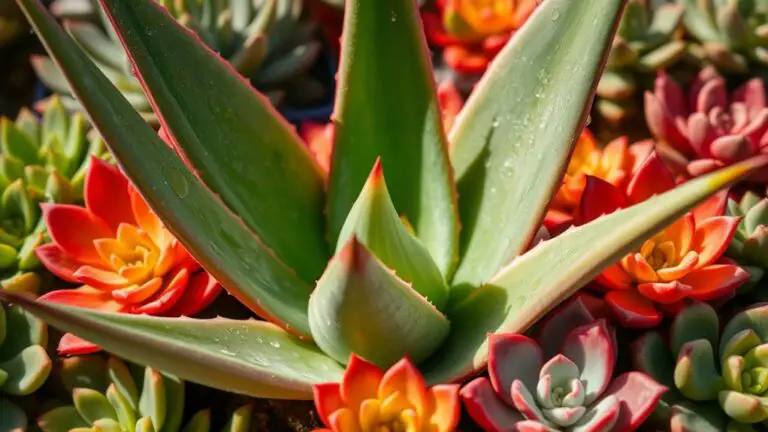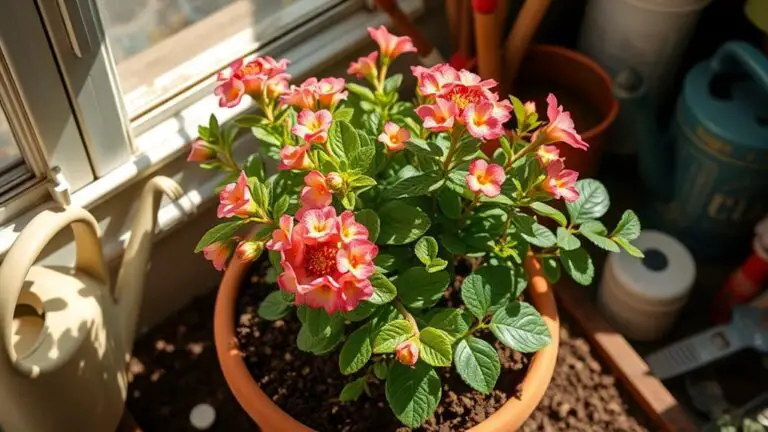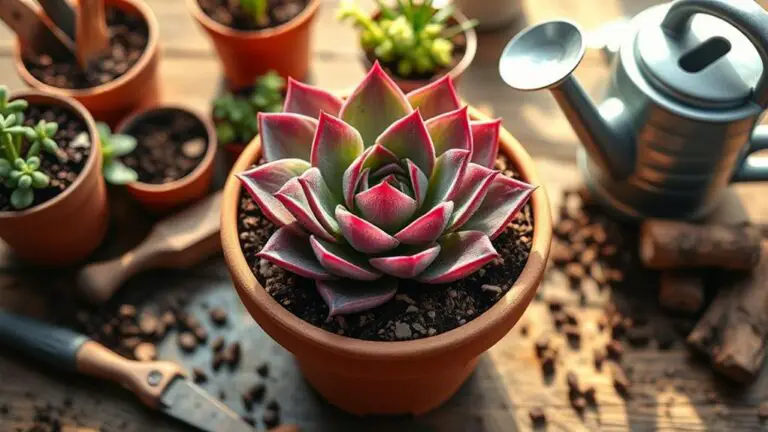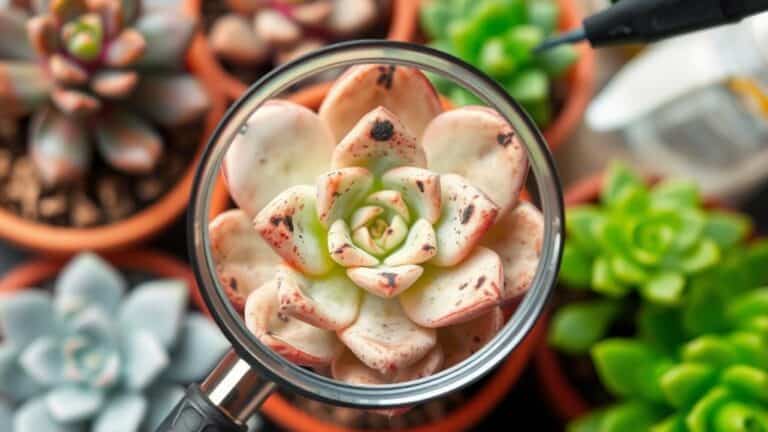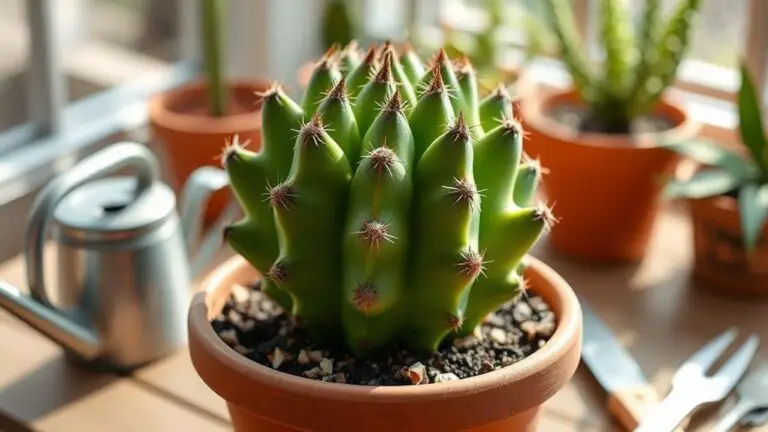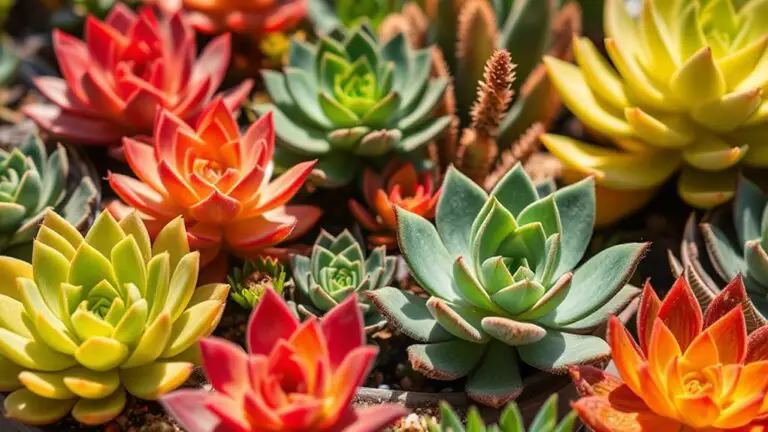How to Care for Echeveria Elegans Mexican Snowball in 7 Simple Steps
Caring for your Echeveria Elegans, also known as the Mexican Snowball, doesn't have to be complicated. You'll need to focus on seven key steps to guarantee it thrives, starting with providing the right amount of light. This succulent loves at least six hours of bright, indirect sunlight daily. But that's just the beginning. How you water it, the type of soil you use, and even the temperature all play essential roles. Curious about the specifics? Let's explore each step to help you master the care of this beautiful plant.
Provide Proper Lighting

To guarantee your Echeveria Elegans thrives, providing the right lighting is essential. This charming succulent needs at least 6 hours of bright, indirect sunlight daily to maintain its compact shape.
Placing it near a south or west-facing window is ideal, as these spots offer maximum light exposure for best growth.
Although Echeveria Elegans can handle direct sunlight, it's important to shield it from intense midday rays. These harsh rays can scorch the leaves, damaging your plant.
If you notice that your plant is getting too much sun, consider moving it to a spot where it gets afternoon shade, especially during the hot summer months.
During the winter months, natural light mightn't be enough. This is where grow lights come in handy. They can supplement the natural light, ensuring your Echeveria Elegans gets the brightness it needs to stay healthy during dormancy.
Use Well-Draining Soil

Using well-draining soil is essential for keeping your Echeveria Elegans healthy and happy.
Create an ideal soil mix by combining regular potting soil with coarse sand or perlite to boost drainage and airflow.
This helps prevent root rot, ensuring your succulent thrives.
Optimal Soil Mix
For Echeveria Elegans, thriving in well-draining soil is vital to preventing water retention and root rot. To achieve this, you should use a soil mix specifically designed for succulents or cacti. These mixes are formulated to guarantee that water doesn't linger around the roots, which is essential for keeping your Echeveria healthy.
A good succulent mix will create ideal drainage conditions. It usually includes larger particles like coarse sand or perlite. These elements help prevent soil compaction, which can hinder root growth and lead to disease. The roots will have plenty of room to breathe, promoting a robust and thriving plant.
The ideal pH level for Echeveria soil is around 7.0. This neutral pH supports the plant's growth, making sure it gets the nutrients it needs.
Regularly check your soil to verify it stays well-draining. If you notice any signs of water retention, like soggy soil or wilting leaves, it's time to adjust the mix.
DIY Soil Blends
Creating a DIY soil blend for your Echeveria elegans can guarantee it thrives in perfect conditions. Echeverias need well-draining soil to prevent root rot and guarantee healthy growth. You can achieve this by mixing regular potting soil with coarse sand or perlite in a 2:1 ratio. This succulent soil mix helps with moisture retention without becoming water-logged.
To enhance your DIY blend, add pumice or crushed granite. These amendments improve airflow and prevent soil compaction, which keeps the roots happy and healthy. Remember, a grainy, porous texture is preferable for Echeverias.
Here's a simple DIY blend recipe:
| Ingredient | Ratio |
|---|---|
| Potting Soil | 2 parts |
| Coarse Sand | 1 part |
| Perlite | 1 part |
The perfect soil pH for Echeveria elegans is around 7.0. This pH level guarantees best nutrient availability and growth. Avoid heavy or moisture-retaining soils, as they can cause root rot. Regularly check the soil's moisture level by inserting your finger to the first knuckle. If it feels dry, it's time to water.
Make sure your pot has drainage holes to let excess water escape. Following these steps will help your Echeveria thrive, giving you a beautiful, healthy plant.
Preventing Root Rot**
To prevent root rot in your Echeveria elegans, it's vital to provide well-draining soil. Succulent plants like Echeveria don't tolerate excess water, so using the right soil mix can make all the difference. A great option is a succulent or cactus potting mix.
Alternatively, you can create your own blend by mixing regular potting soil with coarse sand or perlite. This combination improves drainage, ensuring moisture doesn't linger around the roots.
Regularly checking soil moisture is important. Insert your finger up to the first knuckle into the soil. If it feels dry, it's time to water. Make sure the soil dries out completely between waterings to prevent root rot.
Don't forget to choose pots with drainage holes. These holes allow excess water to escape, keeping the soil from becoming waterlogged.
The ideal soil pH for Echeveria elegans is around 7.0. This promotes healthy growth while keeping soil moisture balanced.
Remember, too much water can lead to root rot, so maintaining the right moisture level is key. By using well-draining soil and pots with drainage holes, you're setting your succulent up for success.
Keep these tips in mind, and your Echeveria will thrive!
Follow Correct Watering Practices

Caring for your Echeveria Elegans starts with mastering the correct watering practices. Succulents like the Echeveria Elegans are drought-tolerant, so it's essential to let the soil dry out completely between waterings. This prevents root rot, a common issue if the soil stays too wet. Use well-draining soil to help the water flow through and avoid overwatering.
During the growing season, which is spring and summer, you should water your plant every 1-2 weeks. To check if it's time to water, insert your finger into the soil up to the first knuckle. If it feels dry, go ahead and water deeply at the base until you see drainage. Always discard any excess water collected in the saucer to avoid soggy roots.
In the fall and winter, reduce the watering frequency to prevent root rot. It's also important not to wet the leaves while watering, as this can lead to rot and fungal infections, especially in high humidity levels.
Maintain Ideal Temperature

To keep your Echeveria elegans happy, aim for temperatures between 60°F and 75°F during its growing season, which is perfect for most indoor settings.
Be sure to protect it from scorching heat and intense midday sun, especially if temperatures reach 90°F.
In winter, move your plant indoors if temperatures drop below 40°F to keep it safe from frost.
Optimal Temperature Range
Maintaining the ideal temperature range is fundamental for the health of your Echeveria Elegans. These plants thrive in temperatures between 60°F and 75°F (15°C to 24°C) during their active growth phase. Keeping your Echeveria within this ideal temperature range guarantees healthy leaf development and overall plant liveliness. Warm conditions are best, but your Echeveria can tolerate temperatures as high as 90°F (32°C) if protected from intense midday sun.
Echeveria Elegans can also withstand cooler temperatures down to 40°F (4°C) during dormancy. However, it's not frost-tolerant, so avoiding cold weather exposure is essential. For outdoor growing conditions, this succulent is best suited to USDA zones 9-12, where temperatures rarely drop below freezing.
If you're growing your Echeveria indoors, maintaining a stable environment is easier. Make sure to keep humidity levels low to moderate, ideally below 50%, to prevent stress on the plant.
| Temperature (F) | Temperature (C) |
|---|---|
| 60-75 (Ideal) | 15-24 |
| Up to 90 | Up to 32 |
| Down to 40 | Down to 4 |
Cold Weather Protection
Shielding your Echeveria Elegans from cold weather is essential to its survival. This succulent isn't frost-tolerant and can suffer damage or even die if exposed to temperatures below 40°F (4°C). Consequently, cold weather protection is imperative, especially during winter months.
If you grow your Echeveria Elegans in containers, bring plants inside when temperatures drop. Place them in a bright location, like near south or west-facing windows, to guarantee they get enough light. This helps them stay healthy and avoid the risks associated with cold weather.
For outdoor plants, keep an eye on the weather forecast. During unexpected cold snaps, cover your Echeveria Elegans with frost cloths or blankets. This can provide just enough warmth to protect them from freezing temperatures.
Verify the soil is well-draining, as overly damp conditions in cold weather can lead to root rot. Wet roots paired with low temperatures are a recipe for disaster.
Fertilize Sparingly

Fertilizing Echeveria elegans should be done sparingly to guarantee the plant thrives without being overwhelmed by nutrients. To promote healthy growth, use a balanced water-soluble fertilizer specifically formulated for cacti and succulents. Apply this diluted fertilizer once a month during the growing season, which spans from late spring to early summer.
This approach assures that your plant gets the right nutrients without the risk of excessive fertilization, which can lead to nutrient burn and harm your Echeveria.
During the fall and winter months, your Echeveria elegans enters dormancy and doesn't need additional nutrients. Avoid fertilizing during this time to guarantee the plant rests properly. Over-fertilizing during dormancy can stress the plant and hinder its growth cycle.
It's essential to monitor the plant's growth and overall health. This helps you determine if it requires any adjustments in fertilization. Sometimes, plants may need more or less nourishment based on their response to the given nutrients.
Monitor for Pests

While confirming your Echeveria elegans gets the right amount of nutrients is important, keeping an eye out for pests is equally essential.
Regularly inspect your plant for common pests like mealybugs and spider mites. These pests can cause significant damage if left untreated. Look for signs of infestation, such as tiny insects, webbing on leaves, or discoloration and wilting. Catching these issues early can save your plant.
If you spot any pests, isolate the affected plant immediately to prevent the spread to healthy specimens. Treat infestations with insecticidal soap or neem oil, following the product instructions carefully for effective control.
Maintaining ideal growing conditions helps reduce the likelihood of pest problems. Confirm your Echeveria elegans has proper watering, making sure water drains well, and adequate light exposure.
Propagate and Prune

Propagating and pruning your Echeveria elegans not only enhances its beauty but also guarantees its longevity and health.
To propagate, start with leaf cuttings, offsets, or stem cuttings. For leaf cuttings, gently twist a healthy leaf from the rosette and let it callus for 12-24 hours. This step is essential as it prevents rot and encourages root growth. Once callused, place the leaf on well-draining soil and provide bright, indirect light.
Offsets are small rosettes that grow around the base of the parent plant. Carefully remove these offsets and replant them in well-draining soil. They'll soon develop into new plants, mirroring the charming rosette shape. Make sure they get plenty of sunlight each day, but not too harsh.
Pruning is equally significant to keep your Echeveria looking its best. If you notice any leggy stems, cut off the top portion and replant it. This encourages new growth and helps maintain a compact shape.
Additionally, keep an eye out for signs of stress like discoloration or wilting. Removing dead leaves will promote air circulation and overall plant health.
Frequently Asked Questions
How to Take Care of a Mexican Snowball?
Give your Mexican Snowball bright, indirect light and water only when the soil is dry. Use well-draining soil, fertilize monthly in the growing season, and watch for pests. Reduce watering and avoid fertilizing in winter.
How to Take Care of Echeveria Elegans?
You'll want to give it bright, indirect sunlight for at least 6 hours daily. Water only when the soil's dry, use well-draining soil, and keep temperatures between 60-75°F. Fertilize during spring and summer.
Why Is My Mexican Snowball Dying?
Your Mexican Snowball might be dying due to overwatering, insufficient sunlight, exposure to extreme temperatures, high humidity, or pest infestations. Check these conditions and adjust care accordingly to help your plant recover and thrive.
How Do You Care for Echeveria Indoors?
Place your Echeveria near a south or west-facing window for bright, indirect sunlight. Use well-draining soil and water only when dry. Maintain 60-75°F temperatures and check regularly for pests to keep it healthy.
Conclusion
Caring for your Echeveria Elegans, or Mexican Snowball, can be fun and rewarding. Just remember to give it bright, indirect sunlight, use well-draining soil, and water only when the soil is dry. Keep the temperature between 60°F and 75°F and fertilize sparingly. Check for pests regularly and prune dead leaves and leggy stems. By following these simple steps, you'll help your plant thrive and enjoy its beauty all year round. Happy gardening!


